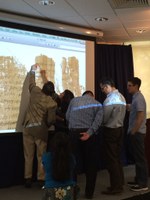ISAW Library: Notes from the North American Papyrological Seminar
Last weekend, May 15-16, 2015, some twenty papyrology, classics, and religious studies scholars and students converged on Hatcher Graduate Library at the University of Michigan in Ann Arbor in order to present work in progress and report on major projects, among them ISAW's Director Roger Bagnall and Head Librarian David Ratzan. This was the first-ever North American Papyrological Seminar (or NAPS I), sponsored by the American Society of Papyrologists (ASP) and generously hosted by the Department of Classical Studies at the University of Michigan.

The idea behind the North American Papyrological Seminars is to increase communication between students and scholars working on papyrological topics by providing a regular, academically informal, but intellectually rigorous forum for presentation and discussion. The plan is to hold NAPS every three years in an off-cycle rotation with the International Congress of Papyrologists convened by the International Association of Papyrologists (IAP), just like the alternating schedule of the modern Winter and Summer Olympic Games. The next IAP Congress will be in Barcelona, August 2016, and so we should expect NAPS II to take place sometime in early 2018.
The inaugural NAPS was a great success. James Keenan (Loyola University Chicago) gave a wonderful keynote address on his career, using it as a backdrop for an intellectual history of papyrology as well as a critique of current practices and directions. The next day was given over to papers of various sorts, from individual editions of documents, including one very interesting Ptolemaic literary or rhetorical commentary presented by William Johnson (Duke), to progress reports on various projects.
Isabelle Marthot and Phillip Sellew (University of Minnesota) presented on the Ancient Lives project, an exciting experiment in crowd-sourcing the transcription of papyrological texts, which is proving to be a useful research and pedagogical tool. Graham Claytor (Basel) reported on the plans to digitize and write the history of the Basel papyri, a project headed by Sabine Huebner, a one-time VRS at ISAW and now Professor of Ancient History at Basel.
David Ratzan's presentation fell into this later category, as he gave a joint presentation with Sarah Goler (Columbia) on the recent work of the Ancient Ink Laboratory (AIL), an interdisciplinary research center at Columbia University dedicated to the scientific and historical study of ancient inks and pigments. The aim of the presentation was to present the methodology and results of the AIL's first sustained research project, a Raman spectroscopic study of ancient carbon inks on papyrus.